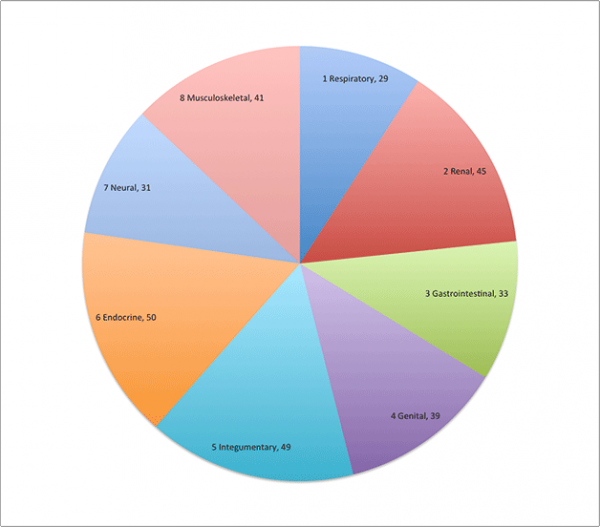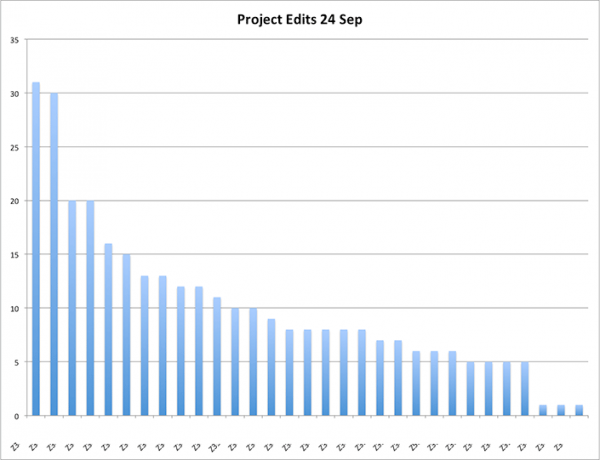|
|
| Line 51: |
Line 51: |
| and the Ureteric bud), I think we need to also write a bit about Historic findings and current research models | | and the Ureteric bud), I think we need to also write a bit about Historic findings and current research models |
| --[[User:Z5030311|Z5030311]] ([[User talk:Z5030311|talk]]) 17:24, 26 August 2014 (EST) | | --[[User:Z5030311|Z5030311]] ([[User talk:Z5030311|talk]]) 17:24, 26 August 2014 (EST) |
| | |
| | |
| | I can do the descending of the kidneys and the development of the bladder (2 and 3) if everyone is fine with that --[[User:Z3465654|Z3465654]] ([[User talk:Z3465654|talk]]) 18:39, 26 August 2014 (EST) |
Revision as of 18:39, 26 August 2014
This is the discussion page for your project.
- Use this page to discuss online the project with your group members.
- Paste useful resources here.
- Remember to use your signature button to identify who you are when adding content here.
- The following collapsed tables provide starting points for students during project work, you also have tutorials built into practical classes and practice exercises for individual assessmet items.
| Group Assessment Criteria
|

- The key points relating to the topic that your group allocated are clearly described.
- The choice of content, headings and sub-headings, diagrams, tables, graphs show a good understanding of the topic area.
- Content is correctly cited and referenced.
- The wiki has an element of teaching at a peer level using the student's own innovative diagrams, tables or figures and/or using interesting examples or explanations.
- Evidence of significant research relating to basic and applied sciences that goes beyond the formal teaching activities.
- Relates the topic and content of the Wiki entry to learning aims of embryology.
- Clearly reflects on editing/feedback from group peers and articulates how the Wiki could be improved (or not) based on peer comments/feedback. Demonstrates an ability to review own work when criticised in an open edited wiki format. Reflects on what was learned from the process of editing a peer's wiki.
- Evaluates own performance and that of group peers to give a rounded summary of this wiki process in terms of group effort and achievement.
- The content of the wiki should demonstrate to the reader that your group has researched adequately on this topic and covered the key areas necessary to inform your peers in their learning.
- Develops and edits the wiki entries in accordance with the above guidelines.
|
|
| Uploading Images
|
 First Read the help page Images First Read the help page Images
The following describes how to upload an image with all the information that must be associated with it.
The image must first be uploaded to the site.
- Open the left hand menu item “Toolbox” and click “Upload file” and a new window will open.
- Click the button ”Choose file” and navigate to where the image is located on your computer and double click the file.
- The window will now show the file name in the “Source filename” window.
- You can then rename the uploaded file in the “Destination filename” window.
- Make sure the new name accurately describes the image.
- Add a description of the image to the “Summary” window. Note the description must include:
- An image name as a section heading.
- Any further description of what the image shows.
- A subsection labeled “Reference” and under this the original image source, appropriate reference and all copyright information.
- Finally a template indicating that this is a student image. {{Template:Student Image}}
Images not including the above information will be deleted by the course coordinator and be considered in the student assessment process.
Students cannot delete uploaded images. Contact the course coordinator with the file address.
|
|
| Referencing
|
 First Read the help page Referencing First Read the help page Referencing
All references used in making your project page should be cited where they appear in the text or images.
In page edit mode where XXXX is the PubMed ID number use the following code.
- <ref name=”PMIDXXXX”><pubmed>XXXX</pubmed></ref>
For references not listed on PubMed, and text can be inserted between <ref></ref> tags.
Where the reference list will appear make a new section and on a new line the following code. <references/>
|
|
| Plagiarism
|
 First Read the help page Copyright Tutorial First Read the help page Copyright Tutorial
Currently all students originally assigned to each group are listed as equal authors/contributors to their project. If you have not contributed the content you had originally agreed to, nor participated in the group work process, then you should contact the course coordinator immediately and either discuss your contribution or request removal from the group author list. Remember that all student online contributions are recorded by date, time and the actual contributed content. A similar email reminder of this information was sent to all current students.
Please note the Universities Policy regarding Plagiarism
In particular this example:
- "Claiming credit for a proportion of work contributed to a group assessment item that is greater than that actually contributed;"
Academic Misconduct carries penalties. If a student is found guilty of academic misconduct, the penalties include warnings, remedial educative action, being failed in an assignment or excluded from the University for two years.
Please also read Copyright Tutorial with regard to content that can be used in your project.
|
|
| Project Analysis 24 Sep
|

--Mark Hill (talk) 09:57, 24 September 2014 (EST) Individual student data for each group has also been analysed.
|

--Mark Hill (talk) 09:57, 24 September 2014 (EST) I have masked student ID.
- Individual students will know how much work you have been doing to date.
- I will be contacting those student on 5 edits or below.
|
2014 Student Projects: Group 1 | Group 2 | Group 3 | Group 4 | Group 5 | Group 6 | Group 7 | Group 8
--Mark Hill (talk) 17:54, 31 October 2014 (EST) These student projects have now been finalised and undergoing final assessment.
| Group Assessment Criteria
|
- The key points relating to the topic that your group allocated are clearly described.
- The choice of content, headings and sub-headings, diagrams, tables, graphs show a good understanding of the topic area.
- Content is correctly cited and referenced.
- The wiki has an element of teaching at a peer level using the student's own innovative diagrams, tables or figures and/or using interesting examples or explanations.
- Evidence of significant research relating to basic and applied sciences that goes beyond the formal teaching activities.
- Relates the topic and content of the Wiki entry to learning aims of embryology.
- Clearly reflects on editing/feedback from group peers and articulates how the Wiki could be improved (or not) based on peer comments/feedback. Demonstrates an ability to review own work when criticised in an open edited wiki format. Reflects on what was learned from the process of editing a peer's wiki.
- Evaluates own performance and that of group peers to give a rounded summary of this wiki process in terms of group effort and achievement.
- The content of the wiki should demonstrate to the reader that your group has researched adequately on this topic and covered the key areas necessary to inform your peers in their learning.
- Develops and edits the wiki entries in accordance with the above guidelines.
|
RENAL SYSTEM
Introduction
Background
Timeline of development - everyone will research first to get general idea of when,what and how long it will develop. Divide this area up from there.
Development of Actual system - all organs and parts that contribute to it (will be divided up later)
Abnormalities
ACTUAL RESEARCH FIRST, THEN DIVIDE. SEE HOW MUCH INFO AND PARTS THERE IS FIRST
ANNOUNCEMENTS
http://www.ehd.org/science_main.php?level=a&submit3.x=73&submit3.y=21&s18=on&ops=&re=on&L1=1&L2=0 have a look at this web site, good time line --Z3463310 (talk) 10:50, 26 August 2014 (EST)
Looks good. There wont be much we can say for all the individual events that occur since all of it is up to the 8th week, but it'll give us a good starting point. We can say 'such and such has been formed during the embryo period' and we can move on from there. I also found the following site which gives a nice intro into the components of the renal system and some general info on each part. Thought we might be able to incorporate a bit of it, talk about what the system/organ does, then follow on how it develops. Use it as a bit of a guide to how we could do our own. http://www.myvmc.com/anatomy/urinary-system-renal-system/ --Z3465654 (talk) 13:48, 24 August 2014 (EST)
https://docs.google.com/viewer?url=http%3A%2F%2Fpediatrics.med.unc.edu%2Feducation%2Fcurrent-residents%2Frotation-information%2Fnephrology%2Ffiles-1%2FNephrogenesis.ppt this web site goes into quite a lot of detail regarding how the renal system develops.
I think in terms of dividing the work:
- 1- urine formation (week 11~12) & amniotic sac
- 2- kidneys descending from where they developed to adult anatomical positions (week 9)
- 3- development of trigone of the bladder and allantois
- 4- structures that arise from the Metanephric mesoderm
- 5- structures that arise from the Ureteric bud
- 6- abnormalities (developmental and genetic)
- 7- introduction
- 8- timeline of events in development
I've thought of 8 topics we can divide the work into, so lets choose 2 each?
I preferably want to do abnormalities and urine formation (number 1 and 6), is that ok? we need this sorted out for our lab homework thing for this week. please reply asap. --Z3463310 (talk) 10:50, 26 August 2014 (EST)
On the actual project page when you expand the bit at the top there are 5 bullet point but the first one is just to come up with our title, shall we divide our project into those 4 different headings?:
Review that system development during the fetal period.
Identify current research models and finding.
Identify historic findings.
Identify abnormalities that can occur in this system during the fetal period
Hey guys, i have now gone and updated the page and added sub-headings as suggested by above, please feel free to add or delete anything you seem unfit for the page. As for the online assessment due tomorrow, i agree that 2 each is appropriate although the timeline will be very long and would be unfair if one person to do the whole thing... We should probably divide the timetable based on weeks and then assign who wants to do what. Although i thought we agreed that i would do the abnormalities as discussed in the last lab...? i have already started to do some research on the topic....
Here is a basic summary of some of the development structures in the renal system, as well as their abnormalities
https://web.duke.edu/anatomy/embryology/urogenital/urogenital.html
--Z3465141 (talk) 16:52, 26 August 2014 (EST)
Ill look at 4 and 5 if that is alright with everyone (structures that arise from the Metanephric mesoderm
and the Ureteric bud), I think we need to also write a bit about Historic findings and current research models
--Z5030311 (talk) 17:24, 26 August 2014 (EST)
I can do the descending of the kidneys and the development of the bladder (2 and 3) if everyone is fine with that --Z3465654 (talk) 18:39, 26 August 2014 (EST)


